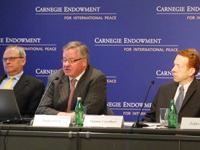Registration
You will receive an email confirming your registration.
Russia’s GDP contracted nearly 8 percent in 2009, under the pressure of collapsing industrial production, plummeting exports, and rising unemployment and poverty. To counter the crisis, the government enacted a stimulus package equivalent to almost 7 percent of GDP.
Carnegie’s Pekka Sutela, the World Bank’s Zeljko Bogetic, and Anders Åslund of the Peterson Institute discussed the effectiveness of the Russian government’s response to the crisis and offered their analyses on where the Russian economy is headed. Carnegie’s Thomas Carothers moderated.
The drastic downturn
The panelists explained that the global economic crisis had a strong negative effect on the Russian economy in 2009:
- GDP contracted by 8 percent;
- Industrial production tumbled by nearly 11 percent;
- Exports collapsed by 36 percent; and
- State revenues fell by almost 5 percent of GDP from 2007 to 2009.
Russia’s Fiscal Stimulus
To counter the crisis, the Russian government enacted a stimulus package that increased its expenditures from 33.7 percent of GDP to 40.6 percent of GDP, Bogetic stated.
- Economic Downturn: The Russian government passed the package even as government revenues fell by 4 percent of GDP. As a result, the previous year’s budget surplus turned into a 6.2 percent of GDP budget deficit in 2009, and non-oil balance deficit doubled.
- Stimulus as Social Policy: The Russian fiscal stimulus was aimed at the broader middle class, rather than only the poor, explained Bogetic. The Kremlin focused the stimulus money on “mono-towns” where residents are almost entirely dependent on a single firm or industry for employment, and it increased pensions and the minimum wage.
- Necessary Measures: The panelists agreed that the Russian government’s fiscal stimulus was an appropriate response to the shocks of the financial crisis, and resulted in the relatively quick recovery of the Russian economy.
Sutela added that the Russians were “not unprepared” for the crisis because Russia had accumulated large reserve funds. In the 2020 strategic economic planning program enacted in 2006-2008, Russia made a point of exploring alternatives to what was perceived as excessive resource dependence; and by early 2008, Russian economists were voicing concern over the risks of the global growth boom based on the combination of high export prices and ample availability of global liquidity.
The Nascent Recovery
After its 2009 contraction, the Russian economy is on its way toward recovery, all panelists agreed. This recovery is led by:
- Increased oil prices, which have risen from $34/bl to $85/bl;
- Stronger Russian domestic demand;
- A more flexible exchange rate helps Russia against the backdrop of oil price volatility; and
- The moderation of rising unemployment by an increase in part-time employment and involuntary vacations as a temporary adjustment.
Russia still faces significant barriers to full recovery, however:
- Industrial production is still lagging;
- Despite the easing of monetary conditions, there has not been a significant increase in lending; and
- Unemployment also remains high, especially among young urban males.
Prospects for Reform and Growth
According to the World Bank 2010–2011 economic outlook, Bogetic suggested that Russia will continue to see positive economic indicators:
- GDP growth: Russia’s GDP is projected to grow at 3.5 percent in 2011, which is 3 percentage points higher than the global average.
- Consolidated balance: Russia’s consolidated government balance is likely to return to a neutral balance in 2011, from a previous negative 3 percent balance.
- Account volume: From 2010 to 2011, Russia’s current account volume is projected to fall by $13 billion, while the capital account would increase by $20 billion next year.
- Drivers of growth: Growth will be driven predominantly by the recovery of domestic consumption.
- Projections: Bogetic suggested that Russia will see either medium growth, at 3-4 percent per year, or high growth of 6 percent.
Anders Åslund offered a similar projection, based on possible political scenarios:
- Putin: Following the path set out by Putin, Russia could see a growth in authoritarianism, state capitalism, and protectionism, leading to a 4 percent growth.
- Medvedev: Following the goals of political and economic liberalization sert out by Medvedev, Russia could see a 6.5 percent growth.
Moving Forward
All panelists agreed that key concerns for the Russian economy going forward include high levels of corruption, highly inefficient state corporations, and future problems with infrastructure and human capital skills.
They also suggested ways that a better investment climate and strengthening the financial sector will aid Russia’s long-term recovery. Bogetic concluded that “the crisis has provided an opportunity for reform and impetus to rethink and accelerate public sector, financial sector, and diversification reforms.”
